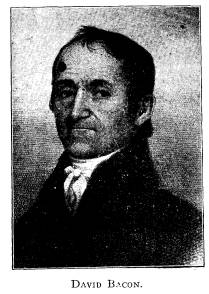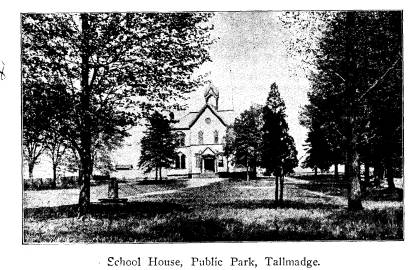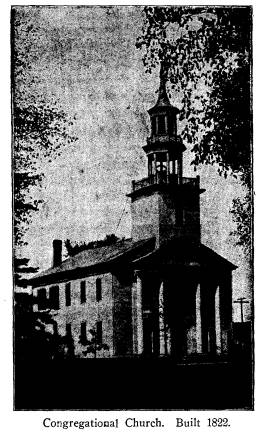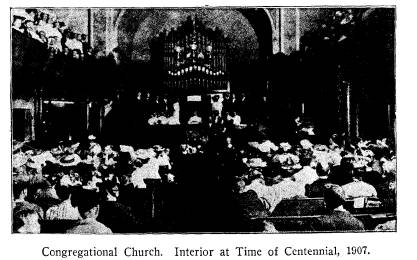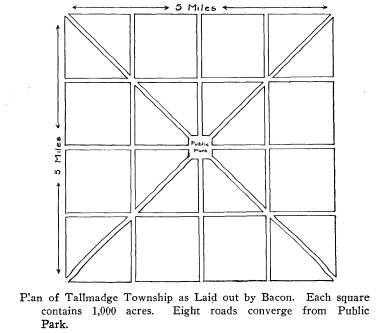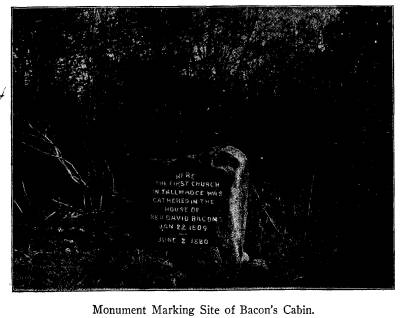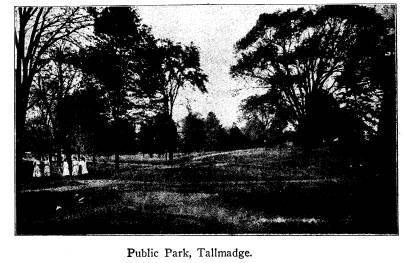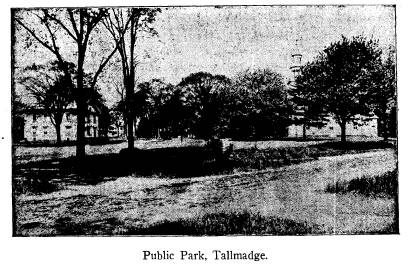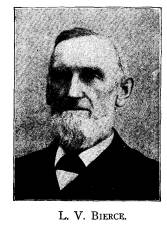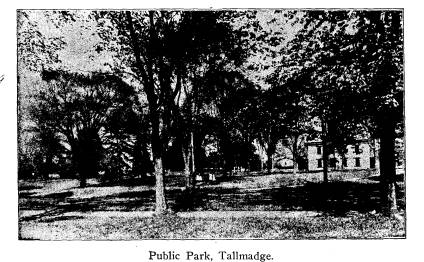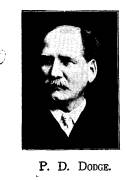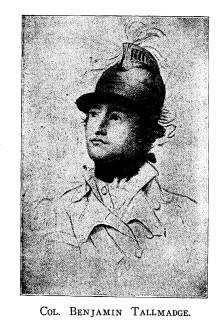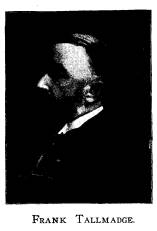Ohio History Journal
|
TALLMADGE TOWNSHIP.
E. O. RANDALL. Six miles east of Akron, the thriving official center of its county, in almost its pristine solitude, pioneer simplicity and primitive picturesqueness, lies the quiet little village of Tall- madge. Its two or three hundred contented inhabitants go their |
|
|
|
in this commonwealth still lingers the influence of its New England ancestry. The form may be much dwarfed and the spirit be weak, but the latter is still potent enough to be felt. To enter Tallmadge is to breathe the atmosphere of the simple life. The vanity and vexation of the twentieth century are strangers to Tallmadge; they would not stay long if they came, they would feel so out of place. This is why we tell about Tallmadge for we have been there and know whereof we speak. (275) |
276
Ohio Arch. and Hist. Society Publications.
Topographically, Tallmadge is four
hundred feet above the
level of Lake Erie, resting on the
"Portage Summit," the eleva-
tion between the rivers Cuyahoga and
Tuscarawas and on the
"carrying trail" over which,
in the early days of canoe travel, the
portable boats were transferred from one
stream to the other,
thus securing connected navigation from
the Great Lakes to the
"Father of Waters." It is in
Summit county, so called because
being the highest land on the line of
the Ohio Canal. Summit
County, carved from Portage, Medina and
Stark Counties, dates
back politically to 1840. These three
latter counties, just men-
tioned, came out of Trumbull. Tallmadge
antedates Summit
County by a generation. That we may
comprehend the indelible
character stamped by its early settlers
upon this town, we must
briefly recall its ancestry and descent.
THE WESTERN RESERVE.
It its a far cry from the throne of the
Charles' in the early
years of the seventeenth century to the
township of Tallmadge
in the beginning of the twentieth
century, but the historical
chain is complete and the links are
easily followed. The disso-
lute monarchs just named granted to
certain favorites portions
of lands in the New World. Renewed
charters were issued by
succeeding Kings until the colony and
subsequent State of Con-
necticut, claimed under its charters, a
strip of territory facing
the New England coast from latitude 41° south to
parallel 420 2'
north and extending west from "sea
to sea." That strip in its
westward extension, it will be seen,
embraced what was later to
be the northern part of Ohio. The
Northwest Territory was
similarly cut into by the colonial
claims of New York, Massa-
chusetts, and Virginia, the latter
embracing the southern portion
of Ohio to-be. We are rehearsing school
boy history, history so
well known that it almost repeats
itself, but thus only may we
get the proper perspective for our
sketch. The American Revo-
lution forever severed the ties of the
mother country to these
colonies, which emerged from that
conflict sovereign States.
These States united into a federal
government claimed the great
territory west of the Alleghanies. It
was claimed by the Indians
who occupied it. It was likewise
demanded by the colonies whose
Tallmadge Township. 277
charters extended through it. The United
States government by
treaties and wars of conquest abrogated
or usurped the rights of
the Indians. One by one the States ceded
their claims to the new
government. Virginia reserved certain
lands between the Great
Miami and Scioto River, known as the
Virginia Military Lands,
to be given as bounties to the
Revolutionary veterans from the
Old Dominion. Connecticut, with Yankee
persistency and fru-
gality, was the last colony to
"give up." This she did on Sep-
tember 14, 1786, then ceding her claims
west of the Alleghanies
except a tract of land bounded north by the international
line,
east by the western line of
Pennsylvania, south by the forty-first
parallel of north latitude and west by a
line parallel with one
hundred and twenty miles west from the
Pennsylvania line. This
western terminus is now the eastern
boundaries of Sandusky and
Huron Counties. This territory
Connecticut reserved, hence its
appellation, "New
Connecticut," and more often the "Western Re-
serve." The United States
government having now got title and
possession of the lands north and west
of the Ohio River by the
famous "Ordinance of 1787,"
organized it into a vast political
territory. But this did not include the
Western Reserve. The
part now embraced in the Counties of
Erie and Huron, and con-
sisting of some 500,000 acres, was
subsequently (1792) set apart
by the General Assembly of Connecticut
to compensate the people
of that colony who had suffered loss,
chiefly from fire, from the
incursions of the British troops during
the Revolution. This tract
has ever since been known as "The
Fire Lands." The Western
Reserve was a worry to Connecticut. It
was too far distant to be
available. It was a howling wilderness
inhabited by savage men
and ferocious animals. A purchaser was
finally found. It was the
Connecticut Land Company. This Company
organized for the
purpose described originally consisted
of thirty-five persons. The
tract, sold without measurement, but
supposed to contain
4,000,000 acres, was contracted for in
September, 1795. The
price agreed upon was $1,200,000 or thirty cents
per acre. The
purchase was made upon credit secured by
mortgages. The
stockholders placed the title in three
trustees. The amount was
divided into 400 shares of $3,000 each.
Anyone paying in a sum
received a certificate entitling him to
an amount of the land pro-
|
278 Ohio Arch. and Hist. Society Publications.
portionate to the payment. The tract was divided into townships of five miles square each, and designated by numbers and ranges. The numbers ran from south to north and the ranges from east to west. The certificates of purchase were numbered and the numbers drawn as in a lottery. Each proprietor therefore drew a township or a fraction of one according to amount paid. The location of this land was determined by lot. The inequalities arising from this method of choice were equalized by giving to those who drew a poor township, a part also of a better one. There were many unique and curious features about this "West- |
|
|
|
ern Reserve" land scheme. One of these features, absolutely with- out similarity in American history, was the question of the political status of the Reserve. When Connecticut sold this terri- tory to the Land Company, she yielded all her right, title and in- terest, jurisdictional as well as to soil. She no longer governed the Reserve. The United States government had no civil juris- diction because the section was never ceded to it. It was an in- dependent, orphan, piece of a previous colony. The Ordinance of 1787 did not cover it. The purchasers made frequent applica- tions to the State of Connecticut to extend her jurisdiction and |
Tallmadge Township. 279
laws over the territory, and to the
United States to accept jurisdic-
tion, but both refused. The Western
Reserve was an anomalous
autonomy, an isolated piece of a
previous colony. In 1800 acts of
Congress and of the Connecticut
Legislature confirmed the title
of Connecticut to the soil o the Reserve
on one hand and re-
leased jurisdiction to the United States
on the other. Thus for
the first time in its history, the
Western Reserve came within any
civil jurisdiction and its people were
protected and governed by
law. From 1795 to 1800 they were
absolutely without laws or
government of any kind. There were no
courts, no laws, no
records, no magistrates or police and no
modes of enforcing or
protecting land titles or personal
rights. It was literally, says
Mr. Hutchins, "No man's land,"
so far as government and law
were concerned. But it was, he might
have added, a veritable
Utopia. It was the acme and dream of
ideal society. "Lands
were bought and sold, personal contracts
made, marriages solemn-
ized and personal rights respected as in
the best governed societies,
and all without government and without
law." It is a peculiar
and perfect picture for the
contemplation of the historian and the
political economist. It was unequalled,
and explained only by the
fact that these self-governing settlers
were the descendants of the
New England stock, the heirs to the
truth, the honesty and honor
of the Pilgrim Fathers. I know of no
incident so illustrative of
the principle of the "square deal
and fair play." When in 1800
the United States took in the Western
Reserve, it became a part
of the Northwest Territory and was
organized into one County,
called Trumbull, after Jonathan
Trumbull, the grand old patriot,
Governor of Connecticut and the original
"Brother Jonathan."
The wilderness of the Western Reserve
began to be broken and
dotted by the settlers from New England,
at first mainly from
Connecticut. One of these settlers now
commands our attention,
for he is the patron saint and martyr of
Tallmadge.
DAVID BACON.
David Bacon, the founder of Tallmadge,
was a native of
Woodstock, Massachusetts, making his
natal entry into that town
early in September, 1771. The English
ancestry of this family
came to America previous to 1640. We are
indebted for our
|
280 Ohio Arch. and Hist. Society Publications. brief summary of the career of David Bacon to articles written by his distinguished son, the late Reverend Leonard Bacon, and published in the Congregational Quarterly, 1876. The family was a typical one of the New England Puritan persuasion. David was trained in the godly thought axed habits of those days. After |
|
|
|
drifting about to various locations, engaged in various avocations, he settled (1799) in Mansfield, Connecticut. His religious nature, inborn and strengthened by education, impelled him to the service of the Gospel among the most benighted of his fellowmen. He resolved to be a missionary to the Western Indians. He was |
Tallmadge Township. 281
not a college graduate nor an ordained
minister, but self-sacrifice,
unusual natural ability, and a desire to
serve the Master, qualified
him for the missionary field. The
missionary spirit was begin-
ning to possess the good people of New
England, and in 1798
the pastors of the Connecticut churches
completed an organiza-
tion called "The Missionary Society
of Connecticut." There still
existed a partial relation, in
Connecticut, of church and State,
and the Governor was authorized to issue
a yearly "brief" calling
for a contribution from each
Congregational parish in the State,
for this missionary society. In the
summer of 1800 David Bacon,
who had read some theology with a
clergyman, was examined by
the committee, "as to his doctrinal
and experimental acquaintance
with the truth," and the examiners
were "fully satisfied with his
answers." Learning that he was
"embarrassed in his worldly
circumstances," the committee
kindly undertook to mediate be-
tween Mr. Bacon and his creditors, but
assumed no responsibility
for his debts. Those debts could not
have been very large, as it
was evidently expected that he would be
able to pay them out of
a salary of "one hundred and ten
cents a day," which was the
compensation to be awarded him for his
services as a missionary,
with an additional allowance for an
interpreter. His field was
designated as the "Indians in the
vicinity of Sandusky Bay or to
some of the Tribes south and west of
Lake Erie." His engage-
ment was for a term not exceeding six
months. Amid fervent
prayers for his success, he bade his
friends farewell and with his
luggage on his back, started alone and
on foot from Hartford
for the then far West. Including
opportunities to catch a ride
now and then, he traveled about
twenty-five miles a day. At
Canandaigua (N. Y.) he met Captain
Chapin, Superintendent of
Indian Affairs, and from him obtained a
letter commending him
to the Seneca chiefs at Buffalo Creek -
now Buffalo City. At
this latter point he was welcomed by Sir
William Johnson, the
Indian agent and interpreter, husband of
the sister of Joseph
Brant, chief of the Mohawks. The Indians
assembled to give
Mr. Bacon audience. One of the speakers
was Red Jacket, the
Seneca orator, who among other things
said the Senecas would
gladly receive a missionary if they
could discover that their white
neighbors were also made better by his
preaching! Bacon reached
282
Ohio Arch. and Hist. Society Publications.
Detroit thirty-four days after leaving
Hartford. He visited and
held council with the Indians at
Mackinac, deciding that the field
in that region was more promising for
his work. The Indians
in that locality were more numerous and
more in need of the
gospel. After two months sojourn in the
Mackinac country, he
retured to Hartford to report his plans
and obtain endorsement
for their execution. The Committee on
Missions approved his
report and his proposals for future work
and the Trustees of the
Missionary Society ordained him to the
gospel ministry. He was
married, on Christmas Eve, at Lebanon
(Conn.), to Alice Parks,
a most attractive and accomplished miss
of eighteen, who was
thenceforth to share the joys and
sorrows of the young minister.
In accordance with his own suggestion,
the Rev. David
Bacon was delegated by the Missionary
Society to Arbrecroche,
some forty miles from Mackinac, and a
center of the Ottawas,
Chippewas, and Ojibways. Thither he proceeded with his
young bride in the midst of winter. But
the religious zeal was
irresistible and his courage dauntless.
He and his wife both in-
tended to learn the Indian languages
that they might better in-
gratiate themselves into the confidence
and friendliness of the
natives. But the obstacles were greater
than they had reckoned.
The Catholic missionaries had been there
before them; more than
all else the heathen of the forest were
debauched by the fur traders
and made suspicious and hostile by the
British and French
Canadians. After months of fruitless
efforts to convert the men
or educate the children the outlook was
"dark and gloomy and
what adds to the gloom, there is little
prospect that it will ever be
otherwise," he wrote home. The soul
of the devout but dis-
couraged missionary was vexed with the
profaneness, drunken-
ness, licentiousness and absolute
ungodliness that surrounded
him. The white man's rum and dissolute
example had done its
deadly work. The reverend and his
intrepid wife made poor
progress in acquiring the Indian
dialects and interpreters for
religious work were practically
impossible. The situation was
graphically set forth in a speech to
Rev. Bacon by Pondegauwan,
a Chippewa chief:
"My father, I have spoken to our
children, to get them to listen
to you, but they tell me that they think
they are too foolish to learn.
|
Tallmadge Township. 283
"My father, we think the Great Spirit did not put us on the ground to learn such things as the white people learn. If he had thought it proper, he would have taught us such things when he put us here. My father, we cannot live together so as to attend to these things like the white people. The Great Spirit has given them cattle and everything about them that they want to live upon. If they are hungry they have only to go into their yard and kill a creature. But he gave us no such things. He put us upon the ground to run in the woods to get our living. When we are hungry, we have to go away and hunt to get something to eat. If we set out in the morning, we may have to run all day to find something, and we sometimes have to go without. My father, we hope you will be disposed to give our people such things |
|
|
|
as they need. And we hope they will do better in future. If it was not for rum, they would like what you have to say to them very well. But rum is our master."
Moreover the personal deprivations and discouragements endured by the Rev. and Mrs. Bacon were almost fatal. They lived in a hut nearly uninhabitable, suffered for proper food and clothing, the remittances due them from the Society did not come or were so delayed as to cause loss and distress. Creditors were clamoring for their pay. Two little ones arrived in the family, adding paternal and maternal joys, but increasing the needs and |
284
Ohio Arch. and Hist. Society Publications.
trials of the household. The details
constitute a pathetic story.
The attempted mission came to an end in
the summer of 1804,
when orders were received from Hartford
for Mr. Bacon to
abandon his efforts among the Indians,
repair to New Connecti-
cut, there await further orders, making
meanwhile a report to the
Society of his financial affairs. After
a journey prolonged by
sickness and suffering the family
reached Hudson (Ohio), where
the wife and children were left and
whence Mr. Bacon proceeded
on, alone, to Hartford. The Missionary
Committee received Mr.
Bacon's report, paid him in full for his
services as missionary to
the Indians and discontinued his labors
in that field. David Hud-
son, founder of the Western Reserve town
bearing his name, and
the Revs. Joseph Badger and Thomas
Robbins, sort of peripatet-
ic pastors in the Western Reserve, urged
the Connecticut Society
to place Rev. Bacon in the New
Connecticut field. It was done,
the Society agreeing to pay half the
expense of the newly ap-
pointed pastor while the local churches,
among which he might
administer, were to bear the other half.
THE TALLMADGE SETTLEMENT.
In March, 1805, Rev. Bacon began his quasi
pastoral work in
Hudson. From this center he went about
the Reserve preaching
in the little settlements, often in
isolated log cabins to a single
family, at times trudging through the
forest like the Apostles of
old without scrip or purse. The wandering experience made
him thoroughly acquainted with the wants
and with the possi-
bilities and prospects of the Western
Reserve in its initial settle-
ments. He was convinced that more could
be done for the estab-
lishment of Christian institutions and
for the moral and religious
welfare of the Reserve as a whole, by
one conspicuous example,
a well organized and well Christianized
township, "with all the
best arrangements and appliances of New
England civilization,
than by years of desultory effort in
itinerant preaching." He
would establish a community of which
religion should be the basic
and inseparable element, a settlement
after the form and spirit
of the early Puritan ideals. "Being
near what was then the west-
ern limit of the progress of settlement
in that region, he looked
about him for a vacant township in which
such an attempt might
Tallmadge Township. 285
be made. Ten miles south from the centre
of Hudson was the centre
of such a township, 'No. 2 in the tenth
Range.' His prophetic
mind saw the exquisite capabilities of
that five-miles square, its
fertile soil, its salubrious air, its
beautiful undulating surface, its
pure and abundant water, its stream
singing in the grand old
woods, and rich with power for the
service of man. He saw
that the proprietorship of it was
chiefly in the hands of men who,
as his trusting and hopeful nature led
him to believe, would enter
into his views, and would even be
willing to sacrifice something
of their possible gains (if need should
be) for so great a scheme
of public usefulness as that with which
his mind was laboring."
Moved by this new call to the cause of
his Master, Mr. Bacon
relinquished his previous engagements
for that of the new enter-
prise, and in the Autumn of 1805
proceeded with his family to
Hartford, a wagon journey of five weeks.
He at once began the
exploitation of his plans and sought for
parties who would aid him
in their prosecution. In the
distribution of the land of the Reserve
among the stock purchasers, Town 2, Range 10, was originally
drawn by two companies called the Brace
Company and the Rock-
well Company; the first consisted of
Jonathan Brace, Justin Ely,
Roger Newberry, Elijah White and Enoch
Perkins; the second
company comprised Azariah Rockwell,
Abram Root, Oliver Dick-
inson and Stephen W. James. Subsequently
Colonel Benjamin
Tallmadge, of Litchfield, Conn., and
Ephraim Starr, of Goshen,
Conn., purchased the interest of the
Rockwell Company and be-
came tenants in common with the Brace
Company. In the prose-
cution of his plans, Mr. Bacon on July 12, 1806, contracted with
Mr. Starr and soon afterwards with Col.
Tallmadge for the pur-
chase of their entire interest in the
township, and with the Brace
Company for a part of their interest-in
all for about 12,000 acres,
at the price of one dollar and fifty
cents per acre. David Bacon,
it is readily imagined, did not pay for
this property at the time of
purchase. He merely made a contract of
purchase, with the
agreement that when any part of the
price was delivered a deed
should be made for the part so paid for.
Mr. Bacon gave the
name of Tallmadge to the township, as
from him the largest
holding had been secured, viz., 6,245
acres. He was also doubt-
less actuated by the fact that the name
of Colonel Tallmadge
|
286 Ohio Arch. and Hist. Society Publications. was the most conspicuous one in New England connected with the Bacon purchase and moreover, that Colonel Tallmadge was in full accord with the religious views and philanthropic plans of David Bacon. The boundary lines of the township were originally surveyed in 1797, and within a few years afterwards, probably before 1805, the township was laid out, under the direction of Gen. Simon Perkins, into twenty-five sections of one square mile each, |
|
|
|
by Caleb Palmer, surveyor. In November, 1806, Mr. Bacon had a new subdivision of the township made by Seth L. Ensign, sur- veyor, into sixteen large lots of one and a quarter miles square and containing one thousand acres each. This last survey has been recognized in all subsequent sales and sub-divisions. The geographical center of the township, according to the plans of Mr. Bacon, was to be the religious, educational and social cen- ter. Five parallel roads running north and south and five par- |
Tallmadge Township. 287
allel roads running east and west cut
the township into the
sixteen equal divisions. In the exact
center of the township was
established the Public Square, from
which radiated four roads
extending respectively to the four
corners of the township. One
can stand, therefore, in the public
square and look down or up
eight straight roads. The great lots
were generally subdivided
into six smaller lots - excepting those
at the center, which were
divided into lots of a few acres each,
for the accommodation of
mechanics and professional men, who were
expected to locate
there. Says Mr. Sill in his
semi-centennial address, "slight as
the relation may appear to a hasty
observer, his (Bacon's) plan
of the township, which may well be
termed a model, has undoubt-
edly produced a marked, abiding and
beneficial effect upon the
character of its inhabitants, and
furnishes evidences of the ab-
sorbing idea and sagacity of its author.
The greatest possible
facility for intercommunication being,
by this plan, furnished to
all sections of the township - the unity
of sentiment and pur-
pose of its citizens, otherwise so
carefully sought after, has been
secured as it scarcely could have been
under other conditions."
Probably no rural town in this state or
elsewhere was sim-
ilarly projected. It was a village with
a heart from which should
flow all excellent influences and to
which should be easily and
irresistibly drawn all members of the
community. Says Leonard
Bacon, son of David: "The
meeting-house at the geographical
centre, with the parsonage, the
physicians' houses, the academy,
the country inn, and the mechanics'
shops and dwellings around
the neighborhood, school-houses at the
corners made by the inter-
section of the parallel roads with the
diagonals, the attraction
drawing all households, on the Sabbath,
towards the central
place of worship where all the highways
meet, the gentle pressure
of the bond of neighborhood, binding
every family to every other
-all this was in the mind of the
projector when he drew the
plan, and was often on his lips while he
was toiling to achieve
the reality." To still further
indelibly implant the influence of
religion upon the settlers in this
community, David Bacon in
all his contracts of sale to
sub-purchasers, inserted a clause
charging every one hundred acres of land
sold with a tax of two
dollars a year for the support of the
gospel -and none could
288
Ohio Arch. and Hist. Society Publications.
have any land at any price or on any
condition except that of
joining the church, and subscribing to
the Saybrook Platform,
which was the ecclesiastical
constitution or state confession of
faith adopted by the state of
Connecticut through legislative en-
actment in 1703. Could the good
David Bacon revert the wheels
of time for a century and transplant in
the Western Reserve the
roots of New England character so they
would thrive and grow?
It was a noble purpose; a courageous
undertaking; but alas for
the hopes of human futility. Mr. Bacon
was the first settler in
his land of promise. With his wife,
three little children, one an
infant six months of age, and an
assistant, Justin E. Fink, the
"Honest and faithful hired
man," the founder of this new re-
ligious kingdom set out from Hudson in
one of the cumbersome,
slow moving wagons of the time. It was
June 24, 1807, when
they halted on the banks of a little
creek, on the south line of the
Township one-half mile west of the north
and south center road.
Here the clearing was made and the
little log hut was erected,
close to the old Portage Path, over
which the Indians passed in
their journeyings. Mr. Bacon was
therefore the foremost pioneer
of his own enterprise. The new city of
David was launched.
And now began the tedious work of
seeking other families who
would enter into his views and actively
co-operate with him in
the permanent establishment of this
isolated Christian commun-
ity. With the exception of George
Boosinger, a German having
no interest in Bacon's plans, who built
a cabin in the south-east
corner of the Township in the Fall
(1807) but left before Win-
ter, Mr. Bacon's family constituted the
only inhabitants until the
Spring of 1808. The recruits to the
settlement began to appear,
but they were few and far between. Many
were the tedious and
prolonged journeys made by Mr. Bacon to
the older Western
Reserve villages to present his claims
and persuade others into
co-operation. With great joy and relief
the arrival of each new
family was welcomed. Slowly the incomers
were enrolled in the
little pioneer circle, from 1807 to
1810--"too slowly for the
hopes, far too slowly for the personal
interest and pecuniary
responsibilities of the founder."
But his religious zeal did not
abate. In midwinter, in the bleak month
of January (1809) the
faithful few assembled in the Bacon log
cabin, which had been
|
Tallmadge Township. 289
the temple of worship from the start, and organized "the church of Christ, in Tallmadge." Baptism and the Lord's Supper were administered. Ten members comprised the little church, organ- ized under the form of Congregational self-government and which "promised to be the best on the Reserve." The writer of this sketch, under the pilotage of Mr. L. V. Bierce, sought the site of this first tabernacle in the wilds of Tallmadge Township. The location is now nearly a mile from the nearest highway, in |
|
|
|
the midst of a spacious wheat field reached by a trackless tramp through meadows and woods. The site is marked by a gigantic glacial bowlder upon the flinty face of which is carved the in- scription: "Here the First Church in Tallmadge was Gathered In the House of Rev. David Bacon, Jan. 22, 1809 -June 2, 1880." The last date is that of the erection of this memorial stone. The church, thus early established, though not including the en- Vol. XVII- 19. |
290
Ohio Arch. and Hist. Society Publications.
tire colony, was really the basis of the
settlement, giving it its
true character and interest from the
beginning. Individuals not
connected with the church, were yet
actively interested in sustain-
ing the institutions of religion, and a
regular mode of contribut-
ing to its support was adopted by the
formation of a society -
members of which need not be
communicants - under the name
of the Congregational Society of
Tallmadge, - with a voluntary
system of taxation upon persons and
property.
BACON'S DISCOMFITURE.
The year 181O brought some
encouragement, for it marked
the arrival of the first settlers that
came directly from New
England; among these Elizur Wright from
Canaan, Conn., "who
brought with him not only a large family
but more capital and
more wealth of culture than any who had
come before him."
Many others deserve mention for their
prominence and subse-
quent efficiency in the development of
the community but space
does not permit us to specify. Thus
originated the Tallmadge
Colony. In the fall of 181O Mr. Bacon
wrote a New England
friend: "There are now in the
Township about thirty families;
we have twenty-five persons who are
professors of religion, but
they have not all of them joined the
church as yet."
The community, however, was never
consolidated into the
Congregational fold. It will be recalled
that Mr. Bacon had not
purchased or contracted for all the land
of the Township. Sec-
tions uncontrolled by him were sold by
the Brace Company to some
settlers not of Bacon's faith, and those
took title free from the
incumbrance as to religious belief or
church tax imposed by Mr.
Bacon. Some holders of this
"unrestricted" property espoused "lib-
eral sentiments which contrasted
favorably with those of Bacon
which have strong marks of a state
religion, as was at that time es-
tablished in Connecticut; those who were
willing to aid voluntarily
in the support of the Gospel, protested
against a tax or involun-
tary and compulsory payment for that
purpose." This non-
conformity on the outside was augmented
by dissension within.
The Napoleonic Wars in Europe and
Jefferson's political poli-
cies in the United States created a wave
of "hard times" in New
England. The tide of emigration to the
west was arrested.
|
Tallmadge Township. 291
"Men in Connecticut who might have emigrated could not sell their farms and were compelled to wait for better times. What money came into the Western Reserve in those days was brought on the current of emigration and the little that came was con- tinually returning in payment for lands as well as for necessi- ties which the wilderness could not yield." There was little buy- ing and selling except by barter. Inevitably under the pressure of such times, the founder of Tallmadge became embarrassed in his business relations to the proprietors in Connecticut. The fulfillment of his contract with his creditors became impossible |
|
|
|
because the land he had agreed to buy could not be sold and he could get no money for the little he had sold. The titles he had conferred upon his settlers were invalidated by his failure to meet his obligations with his Connecticut grantors. Some of his new church members were in danger of losing both their land and whatever partial payments they had made to him. Such an outcome brought strained relations between the good people and the unfortunate but blameless pastor. In the Spring of 1811, Bacon leaving his family in the midst of his discomfiture, set out on horse back for New England. It is a sad scene this last act in the tragic drama of Bacon's plans. Nearly a year he re- |
292
Ohio Arch. and Hist. Society Publications.
mained in Old Connecticut, courageously
and manfully struggling
to save his colony, his credit and the
furtherance of his religious
plans. But the worldly elements were
against him. He could
not stem the tide. The times were out of
joint. "So far as the
proprietor's interests were concerned,
the undertaking of his life
was a failure. Instead of a homestead
with comforts for his de-
clining years, instead of shelter and
support for his wife and
helpless children, nothing remained to
him but the burden of
debts which he had contracted in good
faith and without reason-
able hope of ability to discharge
them." With difficulty he ob-
tained merely means for returning to his
family and of removing
them from the scene of so bitter a
struggle and so great a dis-
appointment. "Broken in health,
broken in heart, yet sustained
by an immovable confidence in God and by
faith that reaches
into eternity, he turned from the field
of hopes that had so
sadly perished and bade his last
farewell to Tallmadge and the
Western Reserve." This was in May, 1812. In Litchfield,
Conn., he taught school to sustain his
family; he preached in var-
ious places; took part in two publishing
enterprises, striving the
while to obtain justice for his
creditors. On August 29, 1817,
in Hartford, Conn., he bade farewell to
earthly strife and passed
to his reward. "His disease,"
writes his devoted son, and faithful
biographer, "was that to which
physicians have given the ex-
pressive name Marasmus, from the
Greek word which signifies to
wither."
We have written the story, unique and
inspiring of
the career of David Bacon. The dreams of
his religious and
philanthropic soul were not to be
realized. But his work was not
in vain. The little village of Tallmadge
lived on and thrived
and became a center of religion,
education and sturdy Chris-
tian manhood, for which it has ever
since been characterized.
The ideas of Bacon were not to meet
their full fruition but
they were not without fruit. His spirit
like the imperishable rock
that marks the place of his first cabin
and church, still abides in
the quiet little town of Tallmadge.
The continuation of the history of
Tallmadge after the de-
parture of its founder is almost as interesting
as its origin, but we
cannot follow this--our task is
practically accomplished when
Tallmadge Township. 293
we have described the beginning. In its
subsequent career were
many curious and amusing incidents
illustrative of the customs
of those pioneer days, one we record as
deserving preservation.
We repeat it from the rare little history of Summit county by
Gen. L. V. Bierce, published in 1857. He
is describing the
erection of the original Congregational
church edifice:
The present elegant, and spacious house
was commenced in 1822.
Reuben Beach, long a prominent, and
worthy citizen, as well as exem-
plary member of the church, was chosen
superintendent of the building.
A day was appointed in which the timber
for the house was to be drawn
on to the ground, and to insure
promptness, Mr. Beach offered a gallon
of whiskey to the man that would get the
first stick on the spot. This
stimulated them to action, and each was anxious to win the prize.
Great
preparations were made the night
before--oxen kept yoked up all night
- timber hauled into the road- and
everything ready for an early start
and fair race in the morning. One man
only appeared indifferent--
that was Daniel Beach, now of Ruggles.
He kept his oxen yoked up, but
had prepared no timber. As soon as
daylight appeared he hitched on
to a fine stick, that Justus Barns had
prepared and drawn into the road,
and before Barns was fairly awake, had
his stick of timber upon the
ground, and got the whiskey. So
expeditious was he that he had been
sitting on his log some time before Mr.
Beach arrived with the prize.
By the time it was fairly daylight the
neighbors had mostly arrived, and
the timber for the whole house was on
the ground. The prize was more
fairly distributed than won, and as the
superintendent was the last
man on the ground it was resolved that
he should be punished by an
exhibition of him, and a proclamation of
the fact, round the Town. He
was accordingly chained on to a sled,
and all the oxen attached to it,
and the balance of the day devoted to
exhibiting him, round town in that
situation.
THE SEMI-CENTENNIAL.
On June 24, 1857, Tallmadge celebrated
its Semi-Centennial,
the fiftieth anniversary of its
settlement. Large numbers of its
early inhabitants, for many were then
still living, gathered to par-
ticipate in the interesting program of
the occasion. The Rev. Car-
los Smith of Tallmadge, called the
assembly to order, the Scrip-
tures were read by Rev. William Monks of
Tallmadge; prayer was
offered by Rev. William Hanford, one of
the oldest clergymen
of the Western Reserve. The historical
address was delivered
by Hon. Elisha N. Sill of Tallmadge. It
was an interesting
account of the origin and rise of the
town, with elaborate detail
|
294 Ohio Arch. and Hist. Society Publications.
concerning the citizens who had taken conspicuous part in its history. Two daughters of David Bacon were present; Mrs. Julia Bacon Woodruff, then of Cuba, N. Y., who was six months of age when her father settled in Tallmadge and Mrs. Alice Bacon Peck, then of Rochester, N. Y., who was born in Tall- madge. Another daughter, who does not seem to have been present, but was then living, was Miss Delia Salter Bacon, born in Tallmadge the last year of the family's sojourn. She was an authoress of note and won great fame as the advocate and first one to give publicity to the theory that Francis Bacon wrote |
|
|
|
Shakespeare. The honored orator of the day was the Rev. Leonard Bacon, born during the Mackinac mission of his father. He became one of the most distinguished divines of the Con- gregational church, wrote many books and was a preacher of great polish and power. The oration was a most scholarly one; naturally in deep sympathy with the occasion, a touching and masterful tribute to the life of a father, the founder of the Chris- tian community, whose survivors and descendants gathered to revive the memories of the early days. The value of and in- terest in the address of Leonard Bacon was greatly enhanced by |
Tallmadge Township. 295
the fact that his memory reverted back
to the little log cabin,
the temple of the Lord, set up in the
wilderness of the Portage
Trail.
THE CENTENNIAL CELEBRATION.
On June 27, 1907, the modern
little town of Tallmadge
fittingly celebrated the one hundredth
anniversary of its birth.
An assemblage of several hundred,
comprising the citizens of
the happy town, nearby neighbors and
those from distant homes,
gathered to participate in the
proceedings. The following pro-
gram, previously arranged by the
centennial committee, was suc-
cessfully carried out: Call to order at
9 A. M.,
by the Rev. P.
D. Dodge, President of the Day:
Reading of Scripture and Prayer
......................Rev. E. J. Smith
Words
of Welcome .........
.......................Rev. Wm. B. Marsh
Settlement of Tallmadge and Early
Days..............Lucius V. Bierce
History
of Schools
................................ ...Miss
Lottie Clark
History of the Congregational Church
....................Rev. S. Upton
History of the M. E.
Church..........................Raymond Barnes
History of the Welsh Congregational
Church ........Mrs. A. C. Jones
At 12
o'clock there was an intermission of two
hours for a
basket picnic dinner and examination of
relics, of which there
was a large and most interesting
collection. The program re-
sumed at 2 P. M., was as follows:
Military History of Tallmadge
.................... Col. Geo. M. Wright
Business Enterprises
............................... Sidney
C. Barnes
Music and Musical
Organizations....................Miss Mary Carter
Benediction ..................................... Rev. Chas. Cutler
The exercises were interspersed both in
the forenoon and
afternoon with music by the Eighth
Regiment Band of Akron.
Additional music was furnished by a
chorus and orchestra of
local talent, attired in old-time
costumes and making a handsome
as well as amusing appearance.
In the evening there were brief
addresses by J. W. Walton
and Sereno Fenn of Cleveland, Mrs.
Isabelle Berry of Akron,
Rev. Homer W. Carter of Beloit, Wis.,
and Rev. J. C. Treat
of Burton, Ohio, all former residents of
Tallmadge.
We regret that space does not permit our
incorporating in
296
Ohio Arch. and Hist. Society Publications.
full in this article the addresses of
the speakers on this interesting
occasion. We can only allude briefly to
one or two of the speak-
ers. As we learned from the Rev. P. D.
Dodge, few townships
have so complete and accurate historical
data, as that of Tall-
madge. This is due largely to the
Tallmadge Historical Society,
organized in 1858. The men who planned
this society were
Chas. C. Bronson, Jas. O. Wolcott,
Andrew Fenn, Lucius V.
Bierce and Lucius C. Walton, who met at
the home of Andrew
Fenn, March 19, 1858, and took the preliminary steps that led
to a complete organization the 24th of
the same month. One of
the founders, Chas. C. Bronson, was
historian of the society for
many years and the results of his
untiring researches are em-
bodied in several closely written
volumes that are of great his-
torical value and are carefully
preserved. Mr. Bronson was for
many years one of the striking
characters of the community. He
was born in Middlebury, Conn., July 5,
1804, and came with his
parents to Tallmadge in 1819. All their
household goods were
lost on the journey. In the struggle
that followed to carve a
farm out of the forest, to build a home
and gain a sustenance,
Charles Bronson developed that sturdy
character for which so
many men and women of those earlier days
were noted. He
died April 11, 1886.
Of the five men who were responsible for
the inception of
the historical society, Mr. Lucius V.
Bierce is the only one now
living. For many years he has been the
society's efficient secre-
tary, which office he still fills with
great acceptance. Mr. Bierce
was born in Athens county, June 2, 1827. He was
left an orphan
in early life and was obliged to shift
for himself while yet quite
young and came to Tallmadge in 1843,
where he learned the
trade of carriage trimmer. By thrift and
economy he acquired a
comfortable village home and later a
nice farm of nearly one
hundred acres close to the center of the
township. Mr. Bierce
is of noted Colonial ancestry, a man of
sterling quality, intolerant
of hypocrisy and shams; has filled many
offices of trust and is
held in the highest esteem by all
people. For more than fifty
years he has been an active member of the Congregational
church, in whose councils his judgment
is still sought and appre-
ciated. Mr. Bierce was secretary of the
committee that planned
|
Tallmadge Township. 297
and successfully carried out the program for the centennial ob- servance of the settlement of the township, and to him and Mr. Sidney C. Barnes, the chairman of the committee, much credit is due for the success of that occasion. To Mr. L. V. Bierce, the secretary of the Tallmadge His- torical Society, nephew of Gen. Lucius V. Bierce, we are in- |
|
|
|
1907, for the town of Tallmadge, in Summit county; the ring- ing of bells and firing of anvils at sunrise to the waking people that the day for celebrating the centennial anniversary of the settlement of the township had come. Early in the day along the roads that lead to Tallmadge there were car- riages, surreys and automobiles with their loads of peo- ple; and every train on the Erie brought hundreds more, until about fifteen hundred were enjoying greetings in the park or listening to the addresses prepared for the occasion, or view- ing the relics displayed in the Town Hall, of which there were over five hundred, a valuable collection to have been gathered in a single township. The centennial of Tallmadge was of peculiar interest because of the unique beginning of the com- munity, and the influence and ideals that have been kept pre- dominant. A community of persons tenacious for cer- tain religious sentiments, and from which those, not in sym- pathy with their views, are excluded, is not an unfamiliar inci- |
298
Ohio Arch. and Hist. Society Publications.
dent in our national life. But that the
people founding a new
community should be bound together by no
peculiar ideas, ex-
cept their absolute adherence to the
accepted Christian beliefs
and practices of their day; and that
they should make the per-
petuation of their simple faith and
practice secure in the be-
ginnings and development of their
community life without
isolation from their neighbors, and with
no peculiarism to up-
hold; all this, and the studied use of
methods for the accomplish-
ment of their purpose to make the
history of the enterprise
unique. In 1807 Portage County was
formed from Trumbull
with a boundary that included what is
now part of several
counties. The principal settlements of
the new county were at At-
water, Deerfield, Hudson, Mantua,
Palmyra and Ravenna. The
county contained probably less than one
thousand inhabitants
at these places, and a few smaller
settlements. Opportunities
for religious worship were few in these
new communities and
would have been almost wholly lacking in
some of them but
for the Connecticut Missionary Society,
which sent missionaries
to the western settlements. The Rev.
David Bacon, one of
these efficient missionaries, conceived
the idea of obviating the
need of missionary effort by founding a
township, 'in which
the religious element should be
incorporated in its beginning,
and be the controlling principle of its
future growth.' The
furtherance of his plan and his methods
for carrying out the
same have been related above. At the
Semi-Centennial of the
founding of the township a speaker said,
'Slight as the rela-
tion may appear to a hasty observer, the
plan of the township
has undoubtedly produced a marked, abiding,
and beneficial
effect upon the character of the
inhabitants.' After another
fifty years the truthfulness of that
statement is not denied. But
the most potent influence upon
succeeding generations that have
grown up in this community is that of a
sturdy ancestry, people
of a rugged faith and exacting life,
sifted at New England at
a time when God had sifted New England
as he had Old Eng-
land two centuries before. Our judgment
upon the habits of
life and the exactions of the Puritan
Fathers and mothers may
be that they were harsh and forbidding,
but judge them by
their children and children's children
and their loyalty to re-
|
Tallmadge Township. 299
ligion, their exacting habits of Sunday observance, their insist- ance upon church attendance, and the maintenance of family worship have moulded their sons and daughters into strong, virtuous and efficient men and women." The addresses at the centennial anniversary were arranged so as to cover the salient points of the history of the township. From these we note that a school was organized as early as 181O, and in 1813, a township library of seventy volumes of standard works was established. That library was maintained for many years and was finally merged into the present school |
|
|
|
library. In 1814 they had a postoffice and a lyceum was organ- ized about that time, and a society of women for literary im- provement in 1815. Was not that the first women's club in the Western Reserve? We find no record of any bridge whist clubs. In July, 1812, Mr. Whittlesey in a letter says: "There are forty houses in this town, all log. The settlers are much the most respectable of any in the Reserve." The men cut away the timber, and burned it, cleared the land and sowed wheat among the stumps, reaped the crops with a sickle, winnowed it by casting it up in the air, and sold it for twenty-five cents per bushel to buy salt at $5.00 per barrel. Life was especially hard |
300
Ohio Arch. and Hist. Society
Publications.
for the women of the household, the
carding, the spinning, and
weaving, and the making of garments for
both sexes were their
labors in addition to the usual duties
of housekeeping. Many
were the distinguished men which
Tallmadge sent forth to the
useful walks of life, among them Leonard
Bacon, the eminent
divine; Julian Sturtevant, president of
Illinois College, and one
of the fathers of Congregationalism in
the west; Elizur Wright,
the most noted insurance actuary of the
age; Col. Charles Whit-
tlesey, famous as a geologist,
archaeologist and historian; Revs.
Aaron Kinnie Wright, Philo Wright,
Samuel Wright and many
others equally deserving of notice.
The pioneers of Tallmadge looked upon
the subject of edu-
cation as secondary only to their
religion, and the early schools
of Tallmadge no doubt had a good share
among the influences
which made the Reserve what it is. Mr.
Bacon in his plan for
the town, arranged for an academy and a
district school at the
center, and a district school at each
six corners. In 1810 the first
school in Tallmadge was held in a little
log building with Miss
Lucy Foster as teacher. In 1836 there
were 763 scholars in
attendance in eleven school districts;
in 1842, 922 pupils.
Those were the days when the teachers
boarded around and
received very small salaries; one of
whom taught for nine
shillings per week and upon getting her
pay for sixteen weeks'
service, she sent the money back to
Connecticut and received
in return three tablespoons at $3.00
apiece and nine teaspoons
at $1.00 apiece. These are all in the
possession of her chil-
dren and grand-children today. Tallmadge
had the first deaf and
dumb school in the state in 1827, an
educated mute from the
East being employed as a teacher. The
third year, a state in-
stitution having been established, the
twelve scholars were trans-
ferred to Columbus. A large frame
building two stories in
height was erected at the center in
1815, money was scarce and
every one was expected to contribute
either money or labor.
The upper room was used as an academy,
and the lower for a
common or district school. This early
academy was of high
character and was the only school in
northern Ohio of a grade
higher than the district school. In 1870 a fine school
building
was erected on the North street and
though this burned in 1876
Tallmadge Township.
301
another soon replaced it. A high school
was established in
1878 with Miss Martha Maltby as the
first principal. Twenty-
six classes have graduated, and they
number 230 members.
The Congregational church, as already
related, was organ-
ized January 22, 1809. Rev.
David Bacon gathered into his
log cabin the few settlers every Sabbath
and preached to them
the gospel of Christ. Later, meetings
were held in other houses
or barns, then in the school houses and
the academy building.
In 1819 the pastor, Rev. M. Woodruff,
preached a sermon from
the words, "Behold now the place
where we dwell is too strait
for us." The academy building had
grown too small for the congre-
gations, a public meeting was held and
$4,600 was raised that
year, and a building committee was
appointed and architect
and builder chosen. These latter went
through the township,
marking the best trees for material with
which to build, and the
twenty-fourth of December was set as the
day for delivering
the logs upon the ground where needed.
There was much rival-
ry as to who should be the first on the
ground Monday morn-
ing, and thus the work began with
enthusiastic devotion. Earlier
in this article we have related an
incident connected with the
erection of this building. In four years
the building was com-
pleted and on the eighth day of
December, 1825, it was dedicated.
Thus after 18 years of struggle the
Congregational church moved
into its permanent home where it has
abided for more than three-
quarters of a century. This church has
had fourteen pastors who
have served loyally and well, and has
received more than thirteen
hundred persons into membership. A
Sabbath school was organ-
ized in 1882, and continues at the
present time. From the first this
church was self-supporting and has been
a liberal contributor
of money to Christian work, and has
given its thousands of dol-
lars, its prayers, and many of its sons
and daughters to the
same grand work. About twenty-five young
members have gone
from the church into the ministry, and
more than that number
as wives of ministers. Many have gone as
teachers in the South,
or as missionaries to foreign lands. The
present pastor is the
Rev. P. D. Dodge.
A Methodist class was formed in 1825
with six members,
and the church with thirty members was
organized in 1832.
|
302 Ohio Arch. and Hist. Society Publications. A building about fifty feet square was erected costing about $1,500. In 1875, the present commodious church building was erected, Bishop Vincent having charge of the dedicatory exer- cises at which subscriptions were raised sufficient to cancel all indebtedness. Tallmadge and Monroe Falls have formed a circuit since 1887. The Methodist church in Tallmadge has done its part towards maintaining the high ideals of the found- ers of the township. Of the military history of Tallmadge, there is much to be said, at least sixteen of the early settlers were veterans of the War of '76 of whom we have authentic record. At the opening of the War of 1812, but five years after the founding of the |
|
|
|
factor in the defensive strength of the frontier; the muster roll of this rifle company contained forty-eight names, officers and men. At least five residents of Tallmadge were in the general service, and five others who afterward came there to live. We have the names of 110 who served in the Civil War, and 64 from Tall- madge joined the National Guard Troops for 100 days. Three young men from Tallmadge have graduated from the United States Military Academy and one from the Naval Academy. Just a word of the faithful, efficient, and patriotic work of the women of Tallmadge in preparing and sending to hospitals and into the field quantities of needed supplies, and with great for- titude carrying on the work at home when many of the able- bodied men had gone forth in the service of their country. Two from Tallmadge were in the War with Spain and the |
|
Tallmadge Township. 303 Philippine Insurrection. Thirty-one former soldiers now reside here. COLONEL BENJAMIN TALLMADGE. 1754-1835. Colonel Benjamin Tallmadge, whose name is inseparably con- nected with early Ohio history, was the son of Reverend Benja- min Tallmadge and Susannah Smith. The Reverend Benjamin |
|
|
|
Long Island and had barely reached New York in safety, when this daring youthful Lieutenant discovered his favorite horse had been left on Brooklyn Ferry. He was determined to save him, not however without being merrily saluted from the musketry of the enemy and finally by their field pieces when in mid-stream. We next find him referred to as Major Tallmadge, having been appointed to take the place of Major Wylls who had been taken prisoner by the British. The valor and the dash of this young officer had already presented itself favorably to General Wash- |
304
Ohio Arch. and Hist. Society Publications.
ington, who appointed him, in the fall
of 1776, as Commander
of the first troop of the famous Second
Regiment of Light
Dragoons. This commission bore date of
December 14th, 1776,
and was signed by John Hancock,
President.
"My own Troop," (he wrote at
the time) "was composed
entirely of dapple grey horses, which
with black straps and with
black bear skin holster covers look
superb. I have no hesitation
in acknowledging that I felt very proud
of this command."
It is to be regretted that this pride
was so soon cut short,
as April 7th, 1777, he was
appointed a field officer, and was en-
gaged in every battle at this period of
the war, at Short Hills
and the Brandywine. In the battle of Germantown,
at the com-
mand of Washington, he made skillful but
ineffectual attempts
to check the retreating Americans by
repeatedly throwing his
squadron across their path. When the
Army went into Winter
quarters at Valley Forge, Tallmadge
received an appointment
to the command of an advanced corps of
observation, consist-
ing of a picked detachment of Dragoons.
At the Rising Sun
Tavern one day, in full view of the
British outposts, he was in
consultation with a country girl he had
sent to Philadelphia to
obtain information of the enemy, when he
observed the enemy's
light horse bearing down on them at full
speed. He caught the
girl and threw her up behind him and
made for his own lines
amidst the firing of pistols, wheeling
and charging throughout,
while the girl sat immovable as a
statue, the embodiment of fem-
inine nerve. "I was delighted with
this transaction," wrote the
Major.
The scene of action for young Tallmadge
now changes to
the Hudson, having been placed in secret
service work for Wash-
ington, and here began a lasting
friendship between himself and
his Commander-in-Chief. Washington was
never caught off his
guard, and learned to honor and love the
young dragoon, as the
many letters from Washington to
Tallmadge so fully attest.
History records in detail the capture of
the British spy,
Andre, by Major Tallmadge, who was
present at the execution.
On the 13th of May, 1783, the
Society of the Cincinnati
was inaugurated and Major Tallmadge
chosen Treasurer of the
Connecticut branch. The Major retired
from the Army with the
|
Tallmadge Township. 305 rank of Colonel and returned to his father's home, where an ox was roasted in his honor. He married Mary Floyd, March I8, 1784, daughter of General William Floyd, who signed the Dec- laration of Independence, for which act the British offered one thousand pounds for his head. Then with his young wife he went to Litchfield, Connecticut, having purchased a home, the same being still in the possession of his descendants. Here the Colonel entertained Washington and also Lafayette, and here lived fifty years. From 1800 to 1816 he represented his district in Congress. He became the owner of much land in the West- ern Reserve, and as has been fully related, had a Township in Summit County, Ohio, named after him. He was also a member of the Ohio Company, that settled Marietta, though it cannot be ascertained that he ever came west.
FRANK TALLMADGE. Frank Tallmadge, for fifty years a resident of Columbus, Ohio, is the eldest in Ohio in either lineal or collateral line from |
|
|
|
many large industries in Central Ohio. Married May Hedges at Pittsburg. Two sons resulted from this union, the elder, Trafford Brasee married Ethel Thompson, of Terre Haute, In- diana, and they have one son, Trafford Wood. The younger Vol. XVI1 -- 20. |
|
306 Ohio Arch. and Hist. Society Publications. son, Harold Hedges, was united in marriage to Agnes Lee Smith in January, 1907, and died at Columbus in March, 1908, leaving no issue. Mr. Tallmadge has long been interested in local historical matters, is a life member of the Ohio His- torical and Archaeological Society, and a member of the Society Sons of the American Revolution. He was the only representa- tive of the family at the Tallmadge Centennial June, 1907. Mr. Tallmadge's home in Columbus is replete with valuable family relics and curios, some of the rooms being appointed and fur- nished after the style of the early Colonial days. |
|
|
